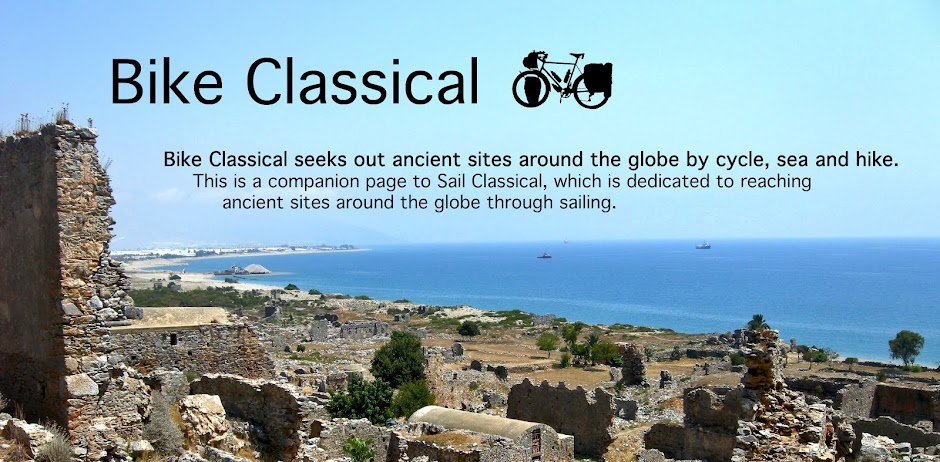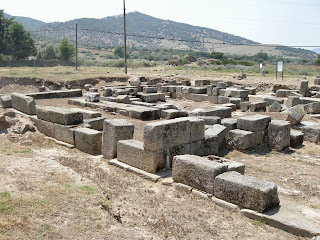Photos by Jack A. Waldron
Turning off the main road at Cine, and following the narrow country path bounded by the farms that dominate the vast plain of the Cine River, I cycled about seven kilometers to foot of the hills that once destined for ancient Alinda and further on to the sanctuary of Labranda, but here, surmounting the outcrop within its ancient walls, was this nest (pictured above) that guarded the a city of Alabanda, which today sits within the village of Araphisar.
In the village of Araphisar, that mingles within the ancient city, most houses having made use of the ancient blocks that lay all around, there wasn't a sole to be seen. I leaned my bicycle against a stone fence, and slowly climbed up into the ruins until I reached the Hellenistic theater (Hellenistic, because its cavea is greater than a semicircle).
Since my time Turkey, I have heard some interesting tidbits with regard to scorpions, and why I am mentioning this now is, according to ancient texts, Alabanda was reputed to be the home of great numbers of these creepy crawlies; and as for the tidbits on the subject, well, I have heard that Turkish army soldiers are instructed to dig a two inch deep mote around their tent, and fill it with water, because scorpions hate water, which Alabanda appeared to be devoid of.
The name Alabanda is said to be derived from the combination of two Carian words, ala, meaning horse, and banda, meaning victory. Its name changed at the end of the 3C BC to Antiocheia of the Chrysaorians under the Seleucid king, Antiochus III, but shortly thereafter, following its capture in 201 BC by Philip V, the Macedonian king, and father to Alexander the Great, it reverted back to Alabanda in 190 BC.
The theater building as a structure is in a decent state of preservation, and though a major part of the seating has been quarried throughout the centuries, the orchestra is filled with numerous building members that have been cataloged, and await the possibility of being reconstructed back into their original places. Amongst the fluted marble columns sits a pediment with an engraved shield motif (pictured below).
In the picture above, I am pointing to the decorated footings of the theater seating, which are carved to resemble the lower leg and paw of a lion. Below, situated atop the theater, a long abandon house that is constructed with blocks quarried from ancient buildings.
A high wall was built around the orchestra during the Roman period in order to protect the audience from harm during gladiatorial and animal hunt exhibitions. The stage building appears to have been modified during the theaters active period, while the skene and proscenium seem to be a mishmash of pooled building members, yet still discernible till this day.
As a Hellenistic theater design, there would not have been a storied skene backing the stage, however, during the Roman period, the stage building would have been modified to include an elaborately ornamented backdrop.
Pictured above, the side entrance to the stage building. Notice how the theater retaining walls angle inward toward the cavea as a result of their being greater than a semi-circle.
As part of the rebuilding of the stage building, Doric capitals and their columns were repurposed from the Temple of Zeus Chrysaoreus (pictures of the Temple of Zeus Chrysaoreus are further down).
Walking from the theater to the slope of the adjoining hill, I found my way through the maize of dirt paths wind up and down between the farm houses that dot the site until I finally found the Temple of Zeus Chrysaoreus (pictured below). This magnificent temple, with an 11 column by 6 column peristyle and no opisthodomos, dates from around 200 BC.
Column drums and sekos blocks are cataloged, ordered and placed near the temple for possible reconstruction. Though the Doric capitals were used in the building of the theater skene during the 4C AD, it is possible to make copies of the capitals, thus allowing the repatriation of the originals to the temple in order to re-set the architrave blocks, which also appear to have been repurposed in the theater skene, and may also need duplicates.
Leaving the Temple of Zeus Chrysaoreus, I walked down the hill toward the city center until I came to the Temple of Apollo Isotimus (pictured below), which was an important deity of Alabanda, and means 'equal in honor'. Again, dating from around 200 BC (as does the Temple of Zeus Chrysaoreus, the Temple of Apollo Isotimus also lacks an opisthodomos.
An altar for sacrifices (such as the one pictured above), may have been placed near the temple. Pictured below, a sunken inner chamber within the temple.
Not far from the Temple of Apollo Isotimus is the Byzantine gate (pictured below), which was part of the greater fortification walls of the city.
Continuing down the hill into the city center, the agora sits within an olive grove, and further, is difficult to recognize, as its colonnades and porticoes are gone, buried or repurposed. Nowhere to found are the dedicatory stones, statues or other monuments that once would have adorned the agora.
Spectacular Anta capitals such as the these on display at the Aydin Archeological Museum, would have sumptuously decorated the grand public buildings of Alabanda, where these were found.
Finally, walking out of the agora onto the flat marshy plain, the very well preserved Bouleuterion of Alabanda awaits the needed attention it deserves. Alabanda is not on the tourist track, and thus, does not command the resources necessary to excavate and reconstruct its buildings in a timely manner.
Pictured above, this outer wall of the bouleuterion stands three stories high, with the bottom story buried in soil, as is the first story of the entire structure. The building dates from the late Hellenistic period, and has similar architectural features to the bouleuterions at Tralles and Termessos.
I always wish I had more time to spend at each ancient city, perhaps a week or more at each site would allow for more selection and discovery. I always look back wanting more from each site, knowing that I will probably never visit them again. Now, on to ancient Alinda, which sits above the modern village of Karpuzlu.
*All photos and content property of Jack A. Waldron (photos may not be used without written permission)
**If you'd like to help with future postings, please feel free to support them through PATREON:













































No comments:
Post a Comment
Note: Only a member of this blog may post a comment.